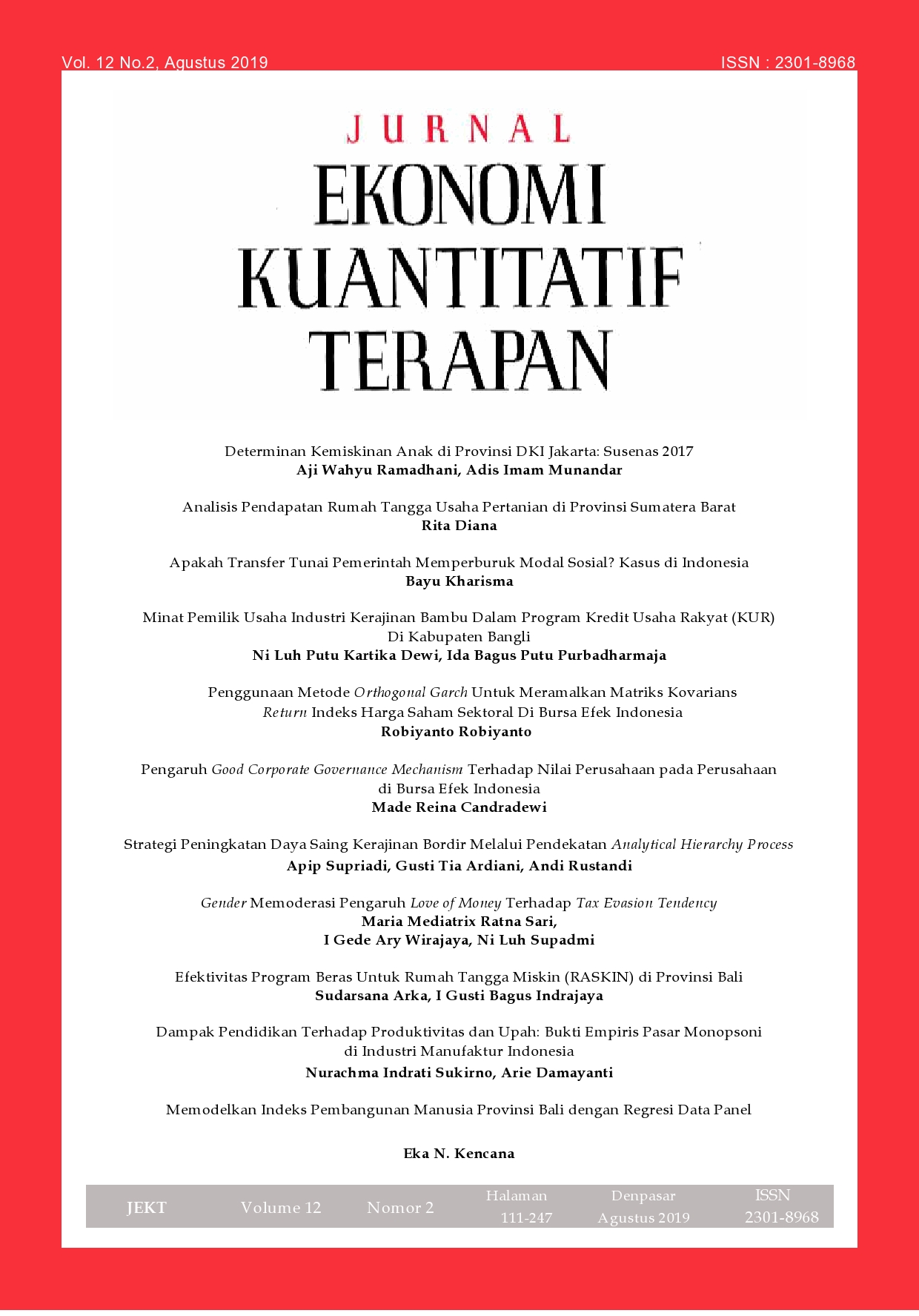Dampak Pendidikan Terhadap Produktivitas dan Upah: Bukti Empiris Pasar Monopsoni di Industri Manufaktur Indonesia
Abstract
Teori Human Capital mengatakan bahwa tenaga kerja yang berpendidikan lebih tinggi akan mendapatkan upah yang lebih besar karena mereka memiliki produktivitas yang lebih tinggi. Namun bukti empiris menunjukkan peningkatan produktivitas tidak selalu diikuti oleh peningkatan upah. Hal tersebut menggambarkan adanya degree of monopsony yang dimiliki perusahaan kepada tenaga kerjanya. Penelitian ini meneliti adanya degree of monopsony yang berbeda antar sektor dengan cara melihat hubungan antara komposisi tenaga kerja berdasarkan level pendidikan terhadap productivity-pay gap/rent sharing yang didapatkan oleh industri manufaktur Indonesia pada kurun waktu 1996 dan 2006. Pengukuran rent sharing yaitu selisih antara produktivitas tenaga kerja dengan rata-rata pengeluaran upah tenaga kerja yang dibayarkan oleh perusahaan. Penelitian ini menggunakan pooled cross section data yang dikontrol dengan dummy tahun, dan diestimasi menggunakan metode Ordinary Least Square (OLS). Hasilnya menunjukkan bahwa sebagian sektor industri manufaktur memiliki degree of monopsony terhadap tenaga kerja yang berpendidikan menengah dan tinggi, ditunjukkan dengan rent sharing positif yang didapatkan perusahaan jika menggantikan tenaga kerja yang berpendidikan rendah dengan tenaga kerja yang berpendidikan menengah dan tinggi. Semakin tinggi level teknologi produksi suatu sektor maka semakin besar degree of monopsony sektor tersebut terhadap tenaga kerja yang berpendidikan tinggi.
Downloads
References
Badan Pusat Statistik. (1996). Statistik Industri Besar Sedang. Jakarta
Badan Pusat Statistik. (2006). Statistik Industri Besar Sedang. Jakarta
Badan Pusat Statistik. (1996). Survei Tenaga Kerja Nasional. Jakarta
Badan Pusat Statistik. (2006). Survei Tenaga Kerja Nasional. Jakarta
Becker, G. S. (1993). Human Capital: A Theoretical and Empirical Analysis, with Special Reference to Education. The Economic Journal (Vol. 76). https://doi.org/10.2307/2229541
Bhaskar, V., Manning, A., & To, T. (2002). Oligopsony and Monopsonistic Competition in Labor Markets. Journal of Economic Perspectives, 16(2), 155–174. https://doi.org/10.1257/0895330027300
Bhattacharya, M., Narayan, P. K., Popp, S., & Rath, B. N. (2011). The productivity-wage and productivity-employment nexus: A panel data analysis of Indian manufacturing. Empirical Economics, 40(2), 285–303. https://doi.org/10.1007/s00181-010-0362-y
Biesebroeck, J. Van. (2015). How tight is the link between wages and productivity? A survey of the literature, (54).
Boal, W. M., & Ransom, M. R. (1997). Monopsony in the Labor Market. Journal of Economic Literature, 35(1), 86–112. https://doi.org/10.2298/EKA0773007S
Brummund, P. (2012). Variation in Monopsonistic Behavior Across Establishments : Evidence From the Indonesian Labor Market. Working Paper.
Cahuc, P., & Zylberberg, A. (2004). Labor Economics. Labor Economics, 107–166. https://doi.org/10.1016/S0169-7218(11)02402-6
Crepon, B., Deniau, N., & Perez-Duarte, S. (2003). Wages , Productivity , and Worker Characteristics : a french perspective. Centre de Recherche En Economie et Statistique Working Paper 2003-04, (1980), 1–24.
Fleisher, B. M., Hu, Y., Li, H., & Kim, S. (2011). Economic transition, higher education and worker productivity in China. Journal of Development Economics, 94(1), 86–94. https://doi.org/10.1016/j.jdeveco.2010.01.001
Hacgeland, T., & Jakob Klette, T. (1999). Do Higher Wages Reflect Higher Productivity? Education, Gender and Experience Premiums in a Matched Plant-Worker Data Set (pp. 231–259). https://doi.org/10.1108/S0573-8555(1999)0000241011
Hellerstein, J. K., & Neumark, D. (1999). Sex, wages, and productivity: An empirical analysis of Israeli firm-level data. International Economic Review, 40(1), 95–123. https://doi.org/10.1111/1468-2354.00007
Hellerstein, J. K., Troske, K. R., & Neumark, D. (1999). Wages, productivity, and worker characteristics: Evidence from plant-level production functions and wage equations. Journal of Labor Economics, 17(3), 409–446. https://doi.org/10.4324/9780203799918
Ilmakunnas, P., & Maliranta, M. (2005). Technology, Labour Characteristics and Wage-Productivity Gaps. Oxford Bulletin of Economics And Statistics, 67(5).
Jones, P. (2001). Are educated workers really more productive ? Journal of Development Economics, 64, 57–79.
Kampelmann, S., Rycx, F., Saks, Y., & Tojerow, I. (2018). Does education raise productivity and wages equally? The moderating role of age and gender. IZA Journal of Labor Economics, 7(1), 1–37. https://doi.org/10.1186/s40172-017-0061-4
Lipsey, R. E., & Sjöholm, F. (2004). Foreign direct investment, education and wages in Indonesian manufacturing. Journal of Development Economics, 73(1), 415–422. https://doi.org/10.1016/j.jdeveco.2002.12.004
Mankiw, N. G. (2012). Principles of Economics (Sixth). SOUTH-WESTERN CENGAGE Learning.
Manning, A. (2011). Imperfect Competition in the Labor Market. Handbook of Labor Economics, Volume 4B (Vol. 4). Elsevier B.V. https://doi.org/10.1016/S0169-7218(11)02409-9
Mustasya, T. (2005). KEBIJAKAN PASAR TENAGA KERJA FLEKSIBEL : TEPATKAH UNTUK INDONESIA SAAT INI ? The Indonesian Institute Center For Public Policy Research, 1–23.
Ours, J. C. Van, & Stoeldraijer, L. (2011). Age , Wage and Productivity in Dutch Manufacturing. De Economist, (April), 113–137. https://doi.org/10.1007/s10645-011-9159-4
Schultz, W. T. (1961). Investment in Human Capital. American Economic Review, 51(1), 1–17.
Takii, S. (2003). Do Education Earnings Differentials Reflect Productivity ?: Evidence from Indonesian Manufacturing 1996. The European Institute of Japanese Studies, Stockholm Schools of Economics, Working Paper, 169(January).
UNIDO. (2016). Industrial Development Report 2016: The Role of Technology and Innovation in Inclusive and Sustainable Industrial Development.
Utari, G. . D., Syarifudin, F., & S. Cristina, R. (2014). Produktivitas dan Upah Optimal Tenaga Kerja Sektor Industri Pengolahan di Indonesia.
Van Biesebroeck, J. (2011). Wages Equal Productivity . Fact or Fiction ? Evidence from Sub Saharan Africa. World Development, 39(8), 1333–1346. https://doi.org/10.1016/j.worlddev.2010.12.002




















